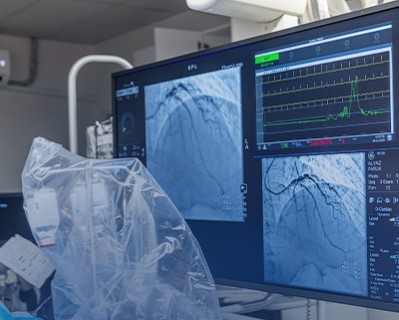Cardiology Treatments

Coronary Angiography
- Purpose: Diagnoses coronary artery disease by visualizing blood flow in the coronary arteries.
- Procedure: A catheter is inserted through the groin or arm and guided to the coronary arteries, where a contrast dye is injected for X-ray imaging.
Note: The information provided here applies to elective situations and assumes there are no extraordinary circumstances or the need for additional interventions. Please note that these details can vary for each patient depending on factors such as proceeding coronary interventions, complications, or other situations like patient-specific health conditions, unexpected findings during the procedure, or individual recovery rates.
Inpatient/Outpatient
Coronary angiography is typically performed as an outpatient procedure. This means that most patients can go home on the same day as the procedure, barring any complications or the need for further interventions.
Hospital Stay Duration
Most patients are monitored for a few hours after the procedure and are usually discharged on the same day. In rare cases, an overnight stay may be required.
Type of Anesthesia
The procedure is usually performed under local anesthesia, with the option of sedation if needed to keep the patient comfortable during the procedure.
Travel After Procedure
Patients are generally advised that they can travel the same day or the day after the procedure, depending on their recovery and the advice of their healthcare provider.
Pre-procedure Preparation
Patients are typically asked to fast for 4-6 hours before the procedure. They may also need to adjust their medications according to their doctor's instructions.
Procedure Duration
The procedure usually takes between 30 minutes to 1 hour to complete.
Recovery Time
Most patients can return to normal activities within a few hours after the procedure, though rest is recommended for the remainder of the day.
Estimated Cost
The cost of coronary angiography can vary depending on the hospital and country. For more detailed information on costs, please contact us directly.
Post-procedure Care
Post-procedure care involves monitoring the catheter insertion site for any signs of bleeding or infection. Patients are advised to avoid strenuous activities for a few days after the procedure.
-_-coronary-angioplasty_20240716165210982043__0.webp)
Percutaneous Coronary Intervention (PCI) / Coronary Angioplasty
- Purpose: Treats narrowed or obstructed coronary arteries by restoring blood flow.
- Procedure: During PCI, a catheter with a small balloon at its tip is inserted through an artery in the groin or arm and guided to the narrowed section of the coronary artery. Once positioned, the balloon is inflated to compress the plaque against the artery walls, widening the artery to improve blood flow. In most cases, a stent—a small mesh tube—is then placed at the site of the blockage to keep the artery open long-term.
-
Note: The information provided here applies to elective PCI procedures without extraordinary circumstances. However, the specifics may vary based on individual patient factors, such as the presence of multiple blockages, underlying heart conditions, or complications that may arise during the procedure. In some cases, the procedure may be more complex, requiring additional interventions or extended hospital stays.
Inpatient/Outpatient
PCI is typically performed as an inpatient procedure, particularly in cases where multiple arteries are treated, the patient has other underlying health conditions, or the risk of complications is higher. Patients may need to stay in the hospital for monitoring after the procedure, especially if it is part of an emergency treatment or if complications arise during the intervention.Hospital Stay Duration
Most patients undergoing PCI are monitored for several hours post-procedure. Depending on the complexity of the procedure and the patient's overall condition, a hospital stay of one or more nights may be required to ensure a safe recovery and to monitor for any potential complications.Type of Anesthesia
Local anesthesia is used to numb the area where the catheter is inserted, typically in the groin or arm. Mild sedation is often administered to keep the patient comfortable during the procedure. In certain cases, such as with patients who may not tolerate the procedure well, general anesthesia may be considered.Travel After Procedure
Travel is generally not recommended for at least 24 hours after PCI, particularly if sedation was used. Patients are advised to consult with their healthcare provider before planning any travel, especially long-distance or air travel, to ensure they are fit for travel and that there are no immediate post-procedure complications.Pre-procedure Preparation
Patients are usually required to fast for several hours before the procedure. They may also need to temporarily stop certain medications, especially blood thinners, under the guidance of their healthcare provider to minimize the risk of bleeding during the procedure.Procedure Duration
The PCI procedure typically takes 1 to 2 hours, although this can vary depending on the number of blockages being treated and the complexity of the case.Recovery Time
Recovery time varies, but most patients can resume light activities within a few days. Full recovery, including returning to normal physical activity, generally takes about a week, though this may vary depending on the patient’s overall health and the specifics of their treatment.Estimated Cost
The cost of PCI can vary depending on the hospital, geographic location, and the specific details of the procedure, such as the number of stents placed. For more detailed cost information, patients should contact their healthcare provider directly.Post-procedure Care
Post-procedure care includes monitoring the insertion site for signs of infection, swelling, or bleeding. Patients will also be prescribed antiplatelet medications to prevent blood clots in the stent and should follow up with their healthcare provider for further instructions on lifestyle modifications, medication management, and future appointments.
_20240716165317590784__0.webp)
Electrophysiology Study (EPS)
- Purpose: Diagnoses and treats abnormal heart rhythms.
- Procedure: Catheters with electrodes are inserted into the heart to map its electrical activity.
-
Note: The information provided here applies to elective Electrophysiology Studies (EPS) without extraordinary circumstances. However, the specifics may vary depending on individual patient factors, such as the complexity of the heart rhythm disorder being investigated, underlying heart conditions, or any complications that might arise during the procedure. In some cases, additional interventions like catheter ablation might be performed during the same session.
Inpatient/Outpatient
EPS is often performed as an inpatient procedure, especially when there is a higher risk of complications or when additional procedures, such as catheter ablation, are planned to treat the detected arrhythmias. Patients may need to stay in the hospital for observation after the study to ensure their heart rhythm remains stable.Hospital Stay Duration
Most patients undergoing EPS are monitored for several hours after the procedure. Depending on the findings and whether additional interventions are performed, a hospital stay of one night or more may be required to monitor heart rhythm stability and manage any immediate post-procedure effects.Type of Anesthesia
EPS is typically performed under local anesthesia at the catheter insertion sites, with mild sedation provided to keep the patient comfortable. In some cases, general anesthesia may be used, particularly if the patient requires additional interventions during the procedure or if the patient’s condition necessitates it.Travel After Procedure
Patients are usually advised to avoid travel for at least 24 hours after EPS, particularly if sedation was used. Depending on the patient’s recovery and whether any additional treatments were performed, longer travel, including flights, may be postponed for a few days.Pre-procedure Preparation
Patients are generally instructed to fast for several hours before EPS. They may also need to temporarily stop certain medications, particularly those that affect heart rhythm, as directed by their healthcare provider to ensure accurate test results.Procedure Duration
The duration of an EPS can vary, typically lasting between 1 to 4 hours depending on the complexity of the heart rhythm disorder being studied and whether any additional procedures, like catheter ablation, are performed.Recovery Time
Most patients can resume light activities within a day or two after EPS, although full recovery may take a few days depending on the patient’s overall condition and the extent of the procedure. Patients should follow their healthcare provider’s recommendations regarding activity levels post-procedure.Estimated Cost
The cost of EPS can vary depending on the hospital, geographic location, and whether additional treatments, such as catheter ablation, are required during the procedure. For specific pricing details, patients should contact their healthcare provider.Post-procedure Care
Post-procedure care includes monitoring the catheter insertion sites for any signs of bleeding, swelling, or infection. Patients will also need to follow up with their healthcare provider to discuss the results of the study and any necessary changes to their treatment plan, including medications or further procedures.

Radiofrequency Catheter Ablation
- Purpose: Treats abnormal heart rhythms by destroying the area of heart tissue causing the arrhythmia.
- Procedure: Similar to EPS, but involves delivering radiofrequency energy to ablate the problematic tissue.
-
Note: The information provided here applies to elective Radiofrequency Catheter Ablation procedures without extraordinary circumstances. However, the specifics may vary based on individual patient factors, such as the type and complexity of the arrhythmia being treated, underlying heart conditions, or any complications that may arise during the procedure. Additional factors, such as the need for multiple ablations or extended monitoring, can also affect the treatment plan.
Inpatient/Outpatient
Radiofrequency Catheter Ablation is typically performed as an inpatient procedure, especially when treating complex arrhythmias or when the patient has other underlying heart conditions that require closer monitoring. Patients may be admitted for observation after the procedure to ensure the arrhythmia has been effectively treated and that no complications arise.Hospital Stay Duration
Patients usually stay in the hospital for at least one night following the procedure. This allows for continuous monitoring of the heart’s rhythm and ensures that any immediate post-procedure complications, such as bleeding or recurrence of arrhythmia, are managed promptly.Type of Anesthesia
The procedure is usually performed under local anesthesia at the catheter insertion site, combined with mild sedation to keep the patient comfortable. In some cases, general anesthesia may be used, particularly if the procedure is expected to be lengthy or if the patient’s condition warrants it.Travel After Procedure
Patients are generally advised to avoid travel for at least 24 to 48 hours after the procedure, depending on their recovery and any post-procedure instructions from their healthcare provider. Longer or more strenuous travel may be postponed for several days to ensure the patient is fully stable.Pre-procedure Preparation
Before the procedure, patients are typically asked to fast for several hours. They may also need to stop taking certain medications, particularly those affecting heart rhythm, as instructed by their healthcare provider to optimize the success of the ablation.Procedure Duration
The procedure usually lasts between 2 to 4 hours, depending on the complexity of the arrhythmia being treated and the number of areas in the heart that require ablation.Recovery Time
Most patients can return to light activities within a few days, though full recovery and a return to normal activity levels may take about a week. It’s important to follow the healthcare provider’s recommendations on activity restrictions post-procedure.Estimated Cost
The cost of Radiofrequency Catheter Ablation can vary depending on the hospital, geographic location, and the specifics of the procedure. Factors such as the duration of the procedure and the complexity of the arrhythmia can also affect the cost. For precise pricing information, patients should contact their healthcare provider.Post-procedure Care
After the procedure, patients need to monitor the catheter insertion site for signs of infection, bleeding, or swelling. Regular follow-up appointments with a healthcare provider are crucial to assess the success of the ablation and to manage any ongoing care, such as adjustments to medications or further treatments if necessary.
_20240719162432222845__0.webp)
Transesophageal Echocardiography (TEE)
- Purpose: Provides detailed images of the heart's structure and function, often used when more detailed imaging is required than standard echocardiography can provide.
- Procedure: A probe is inserted into the esophagus, which is located close to the heart, to obtain high-resolution images using ultrasound.
-
Note: The information provided here applies to elective Transesophageal Echocardiography (TEE) procedures without extraordinary circumstances. However, the specifics may vary depending on individual patient factors, such as the presence of other heart conditions, patient tolerance to the procedure, or complications that might arise during or after the procedure. Additionally, TEE is often performed in conjunction with other diagnostic or therapeutic interventions, which could affect the procedure's complexity and duration.
Inpatient/Outpatient
TEE is typically performed as an outpatient procedure, but in some cases, it may be done in an inpatient setting, especially if the patient is already hospitalized for other reasons or if TEE is part of a more comprehensive evaluation or treatment plan. If complications are expected or if the patient has significant comorbidities, they may be monitored in the hospital for a short period post-procedure.Hospital Stay Duration
Most patients can expect to go home the same day after TEE, typically within a few hours of the procedure. However, if TEE is conducted alongside other procedures or if the patient experiences complications such
